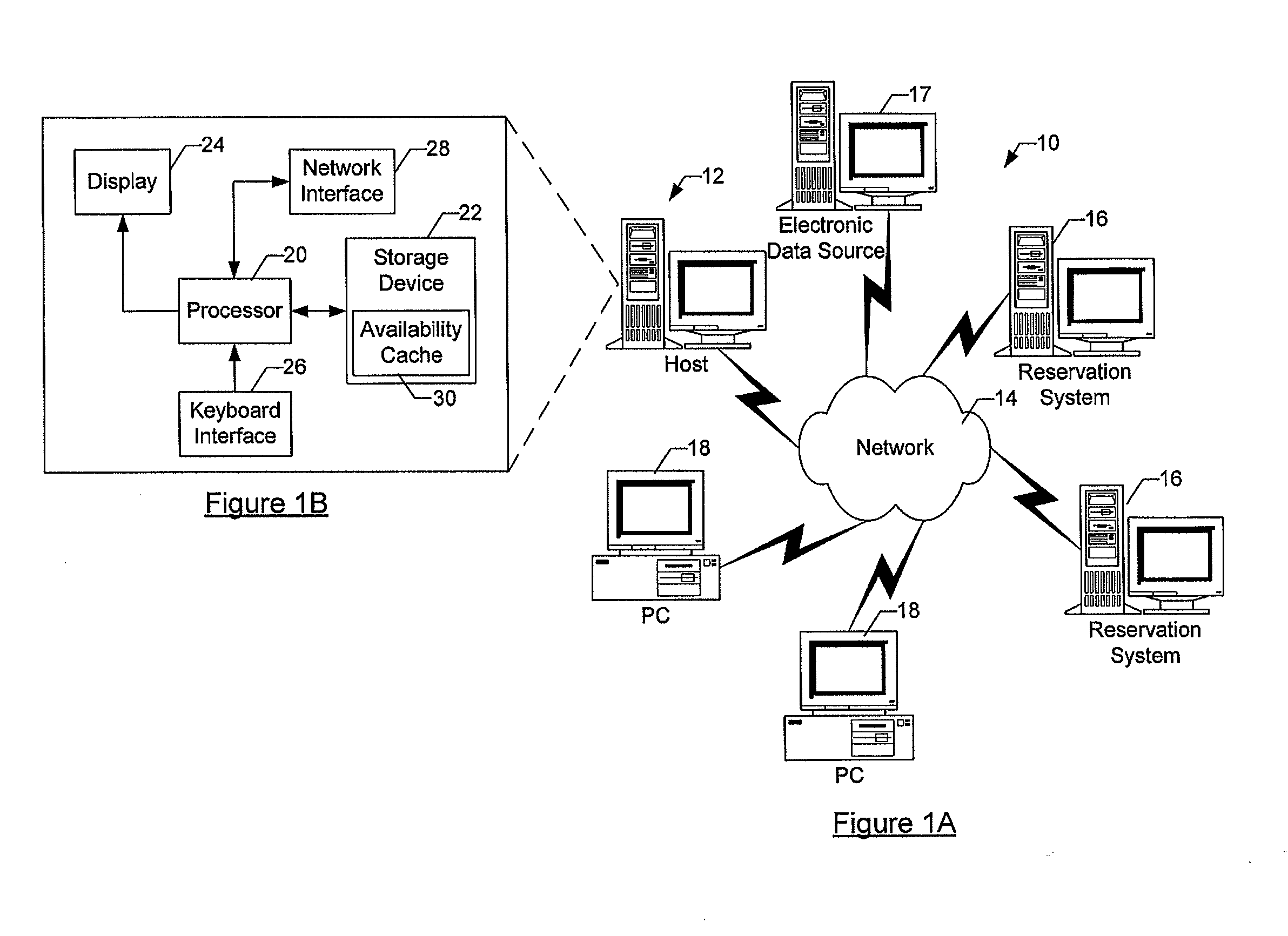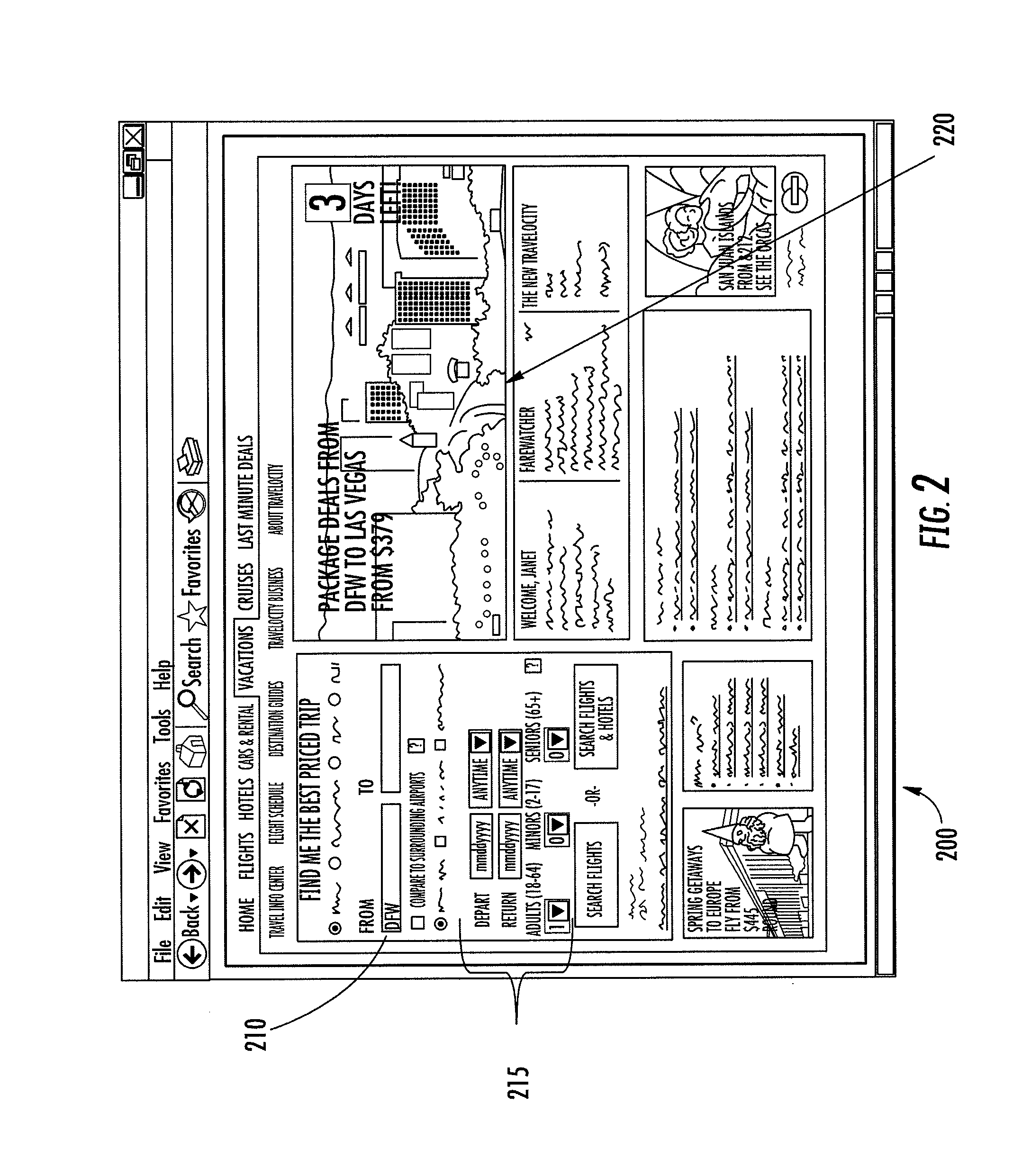These systems may include simple or complex methodologies for maintaining inventory and providing product and / or service availability information.
Initially, these systems were difficult to use and did not always provide the best solution to a
consumer's query.
While these early systems provided timely results and reduced
processing load on the CRS, they did not always provide the best solution to the
consumer.
Unfortunately, such a process may not provide the best solution to a
consumer or may miss an opportunity to market different fares to a customer that may maximize profits for the supplier, while also meeting the consumer's goals.
However, conventional search systems are generally passive.
Thus, while conventional systems may provide low cost flight itinerary options (and, in extended cases, a low cost hotel reservation in conjunction therewith), such conventional search systems cannot provide suggested complete travel itineraries built around a themed vacation experience wherein the theme is, for example, activity-based (e.g., a SCUBA vacation) and / or destination based (e.g., a Broadway vacation planned around ticketed shows).
Furthermore, while travel agencies and / or
specialty travel providers have for many years offered themed vacation “experiences” these services are unable to provide themed interactive itineraries built around low-cost travel products stored in a plurality of inventory systems.
Furthermore, even “
package” deals offered by existing travel agencies often lack flexibility, and do not afford travelers the opportunity to customize with additional activities and / or other travel products selected from a plurality of travel product inventory systems.
Furthermore, conventional search systems and / or travel agencies also lack the capability to show a traveler, in near real-time, the pricing change(s) caused by the addition and / or removal of selected travel products from a vacation itinerary.
In addition, when selecting travel products to complete a travel itinerary, a traveler is often forced to select travel products without the benefit of prior knowledge of the geography, distances, street
layout, and / or other logistical details of a destination.
Furthermore, the traveler may be unaware of peculiarities of timing, geography, and / or transportation in New York and thus may be unable to secure a hotel that meets the traveler's expectations and still allows the traveler easy access to shows, restaurants, and / or other activities.
Furthermore, because conventional search systems do not allow a user to build an itinerary around a suggested schedule (and to place a plurality of travel products in a visual itinerary), the traveler may be unable to properly schedule various activities within their vacation.
Because, conventional search systems do not allow a traveler to place their travel product purchases within a visual itinerary (much less a map), the traveler may be forced to consult and plan their vacation in a separate calendar program and / or day planner in order to avoid conflicts and / or time pressures.
Furthermore, conventional search systems do not allow a traveler to place selected low-cost travel products within a visual itinerary and simultaneously view the result of such selections on the total cost of the vacation.
In addition, conventional search systems may be unable to show the traveler (via a map and calendar itinerary) the cost and
timing results of changing reserved show tickets from an
evening show time to a matinee show time.
These limitations in the current systems may create a burden on inventory systems.
Specifically, since conventional search systems are not capable of displaying travel products for a themed vacation experience in a “skeleton” itinerary format and / or mapping the location of travel activities, airports, and / or hotels on a map of the destination, a user may be required to run multiple searches in order to find a travel product and / or set of travel products meeting the traveler's budget while still being logistically acceptable.
Thus, if such a traveler wishes to plan two activities in a single afternoon /
evening period, the traveler may first select and reserve a first activity (such as a matinee show), however, if the show is not shown on a visual itinerary, the traveler may be unaware of the logistical difficulty of planning a 6:00 PM dinner reservation at a location across town from the theater.
Furthermore, conventional search systems may be incapable of alerting the traveler of a hotel option, for example, that may be closer to a majority of the traveler's planned activities for only $10 more per night than the lowest-cost hotel option.
Conventional search systems lack the capability of combining, in real-time, search capabilities for determining low-cost options for a variety of travel products, with an interactive visual itinerary and / or
mapping system for showing the traveler the logistical and cost effects of making adjustments to a suggested themed itinerary.
Furthermore, conventional search systems have no provision for searching for descriptive data corresponding to the selected travel theme much less displaying the descriptive data in response to a user search for a themed travel itinerary.
While some conventional systems may provide links to such supplemental information, conventional systems do not integrate such data with a visual itinerary and supply it to a user in response to an initial
user input.
As such, the need for additional information places added burden on the
inventory system to process additional requests for such information.
In addition, limitations in the current systems can increase the difficulty in identifying satisfactory options for a trip and reduce the user's confidence that any particular options or particular itineraries are the best options for him or her, thereby reducing the likelihood that the user will actually purchase the travel products associated with a particular trip.
Further, these factors can put additional burden on the
inventory system, since the same user may perform additional searching, even after a satisfactory or optimal itinerary has been found.
 Login to View More
Login to View More  Login to View More
Login to View More 


